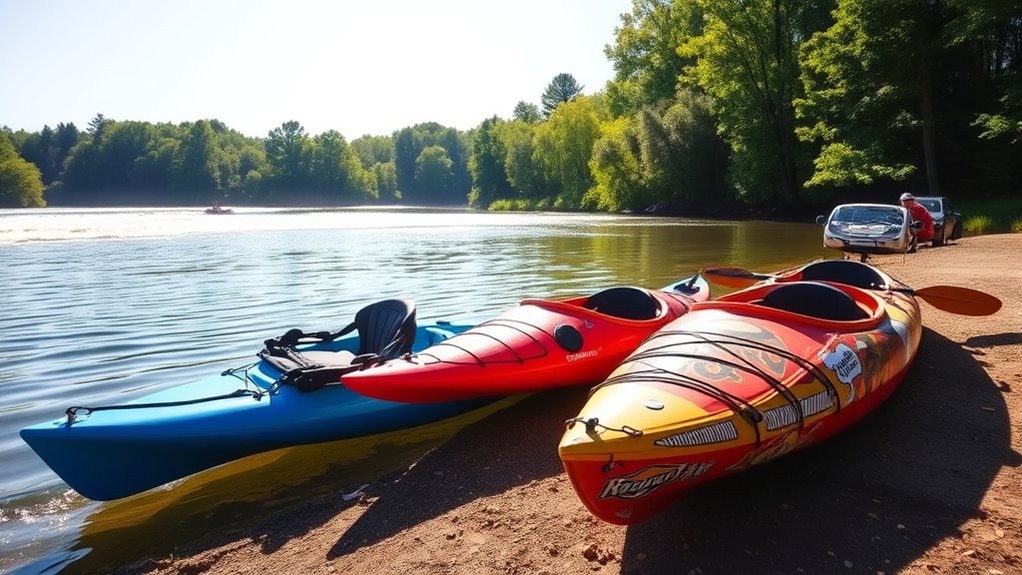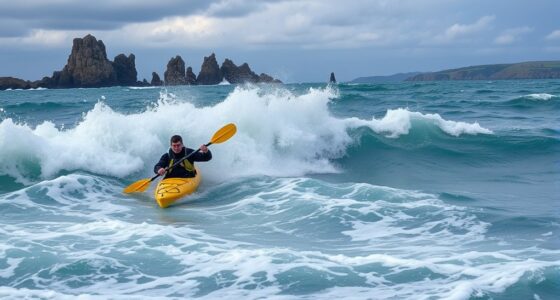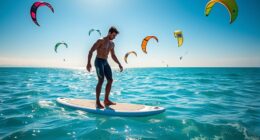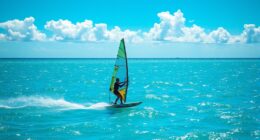When selecting the right kayak, consider your paddling style and the water conditions. Recreational kayaks are great for beginners, offering stability for leisurely paddling on calm lakes. Touring kayaks suit those planning longer trips, providing speed and storage for gear. If you’re seeking thrills in rapids, whitewater kayaks deliver maneuverability but require skill. Each type has its strengths, so it’s important to match your choice to your needs and environment. There’s so much more to explore on this topic.
Key Takeaways
- Choose recreational kayaks for beginners or leisurely paddling on calm lakes, emphasizing stability and ease of use.
- Opt for touring kayaks for longer excursions, designed for efficiency with their narrow shape and ample storage for gear.
- Select whitewater kayaks for navigating rapids, offering high maneuverability but requiring skill and practice for safe handling.
- Consider your environment and intended water conditions when selecting a kayak type to ensure safety and enjoyment.
- Match your paddling style with the appropriate kayak to enhance your overall kayaking experience and comfort on the water.

When it comes to selecting the right kayak, how do you know which one fits your needs best? The type of kayaking you plan to do plays a significant role in your decision. Whether you’re looking for a recreational kayak for calm lakes, a touring kayak for longer trips, or a whitewater kayak for steering rapids, understanding the differences will help you choose wisely. Each type has unique features suited for specific environments and activities.
Recreational kayaks are perfect for beginners or those who want a leisurely experience. They’re generally wider, providing better stability, which is vital for kayak safety, especially if you’re new to the sport. These kayaks are easy to maneuver and often come with built-in storage solutions to hold your snacks, drinks, or extra gear. If you’re planning to paddle on calm waters, a recreational kayak will give you a comfortable and enjoyable ride.
Recreational kayaks offer stability and ease of use, making them ideal for beginners seeking a relaxing paddling experience.
On the other hand, if you’re considering longer trips or multi-day excursions, a touring kayak might be your best bet. Touring kayaks are longer and narrower, designed for speed and efficiency on open water. They usually have more advanced storage solutions, allowing you to bring along essential gear and supplies for extended outings. However, be aware that their design can make them less stable than recreational kayaks, so you’ll need to prioritize kayak safety and practice your balancing skills. These kayaks often have bulkheads and hatches for secure storage, which helps keep your belongings dry.
If you crave excitement and adventure, whitewater kayaking could be your calling. These kayaks are specifically designed for steering rapids and rough waters, featuring shorter, more maneuverable shapes. While they may not have extensive storage solutions, they usually come with secure compartments for essential safety gear, like helmets and life jackets. Safety is vital in this type of kayaking, as the unpredictable nature of whitewater can pose significant risks. You’ll need to be comfortable with the challenges of fast-moving water and practice your skills to guarantee a safe experience.
Ultimately, choosing the right kayak boils down to your paddling style and the environment where you’ll be kayaking. By considering the type of water you’ll be steering, your experience level, and your need for storage solutions, you’ll find a kayak that suits you perfectly and keeps you safe on the water.
Frequently Asked Questions
What Is the Average Lifespan of a Kayak?
The average lifespan of a kayak is about 10 to 15 years, depending on usage and care. Proper kayak maintenance is essential; regularly check for cracks and clean it after each use. Investing in good storage solutions, like a cool, dry space, can prevent damage from UV rays and moisture. By taking these steps, you can maximize your kayak’s lifespan and guarantee many enjoyable paddling adventures ahead.
Can I Use a Touring Kayak for Whitewater?
You can use a touring kayak for whitewater, but it’s not ideal. Touring kayaks are designed for stability and long-distance paddling, while whitewater kayaks are built for maneuverability and quick reflexes. If you decide to use a touring kayak, you’ll need to adjust your paddling techniques to navigate rapids effectively. The material of your kayak also matters; plastic can handle impacts better than fiberglass in rough waters, so choose wisely!
How Do I Transport My Kayak Safely?
To transport your kayak safely, invest in quality kayak accessories like a roof rack or padded straps. Secure your kayak tightly to avoid shifting during transit. Use foam blocks or cradles for added support. If you’re driving a longer distance, consider a kayak cover to protect it from the elements. For storage solutions, keep your kayak in a cool, dry place, using a wall rack or hanging straps to save space.
What Safety Gear Should I Bring Kayaking?
When you hit the water, think of your kayak as your trusty ship in a sea of adventure. For kayak safety, bring essential gear like a personal flotation device (PFD), a whistle, a first-aid kit, and a paddle float. Don’t forget a sponge or bilge pump for water removal and a dry bag for your phone and snacks. With these items, you’ll be well-prepared to navigate the waves confidently and safely!
How Often Should I Clean My Kayak?
You should clean your kayak after every use, especially if you’ve been in saltwater or muddy conditions. Establish a maintenance schedule to keep it in top shape—rinse it with fresh water, scrub the hull, and inspect for damage. If you notice any wear, address it promptly. Regular cleaning not only prolongs your kayak’s life but also guarantees a safe and enjoyable experience on the water. Don’t neglect this essential task!
Conclusion
In the end, choosing the right kayak is like picking the perfect dance partner; it should match your style and comfort. Whether you’re gliding on calm lakes, exploring coastal waters, or steering rushing rivers, each type offers a unique thrill. Trust your instincts and consider your adventures ahead. With the right kayak, you’ll not only ride the waves but also create unforgettable memories on the water. So, gear up and paddle into your next adventure!










